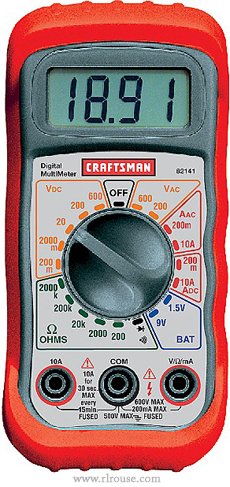 A Digital Multimeter (DMM) is one of the handiest tools you can have in your home or garage. Most people think of a DMM as a “volt meter”, and of course it is. But it is also a whole lot more! Here is a run-down of all the electrical properties that a typical digital multimeter can measure:
A Digital Multimeter (DMM) is one of the handiest tools you can have in your home or garage. Most people think of a DMM as a “volt meter”, and of course it is. But it is also a whole lot more! Here is a run-down of all the electrical properties that a typical digital multimeter can measure:
1. AC Voltage – Measuring AC or DC voltage is far and away the most common application of DMM’s. To measure AC voltage (Alternating Current), simply set the meter to the highest AC range and apply the test leads to the conductors being tested. There is no need to worry about positive and negative because they are irrelevant when measuring AC. Keep lowering the voltage range on the meter until you get the most precise reading possible.
2. DC Voltage – To measure DC voltage (Direct Current), set the meter to the highest DC range then connect the red lead to the positive lug, post or wire and the black lead to the negative lug, post, wire or “ground”. It’s important to make sure the leads are connected with the proper positive and negative polarity or the polarity of the reading could be reversed (and incorrect!). Again, keep lowing the voltage range until you get the most precise reading possible.
3. Amperage – Amperage is the measure of the electric current that is flowing through a component or wire. In order to measure amperage you must connect the meter in series with the circuit being tested. In other words, you’ll need to open up the circuit by disconnecting a wire and connecting the meter’s test leads to the end of the wire and the place where it was previously connected. Then set the meter to the highest amperage setting. A reading of “0.00” means there is no current flowing through the circuit at all. As before, lower the amperage range on the meter until you get the most precise reading possible.
4. Resistance – Resistance is the measure of an object’s opposition to electric current flow. All substances have a natural tendency to resist the flow of current. Some substances such as metal or water have such low resistance that we refer to them as conductors. Others such as plastic and glass have such a high resistance that we refer to them as insulators. Your DMM’s Resistance scales will allow you to check the amount of resistance exhibited by electrical components.
To measure resistance simply set the meter to the highest resistance scale and connect the test leads across the component to be tested. As with voltage testing, keep lowering the meter’s resistance setting until you get the most precise reading possible.
When measuring resistance, the initial reading before connecting the test leads will be the numeral “1”. This indicates an open circuit (infinite resistance). After connecting the test leads the numeral “1” will be replaced by the actual resistance reading of the component being tested. If the “1” remains however, that means that the component has infinite resistance (i.e. it is either burned up like a blown fuse or physically broken). A reading of “0.00” indicates a short circuit (zero resistance or extremely close to it).
When set to the lowest resistance scale a DMM makes a dandy continuity checker for wires, fuses, etc. When checking continuity, you really only have to look for one of two readings. A reading of “1” means the wire is not making an electical connection at all (i.e. you have an open circuit). A reading of “0.00” means the connection is good (i.e. the fuse if not blown, the wire is not broken, etc.). Some DMM’s have a stand-alone continuity testing function.
5. Miscellaneous Test Functions – Some DMM’s have additional functions in addition to the four explained above. Mine for example includes the capability to test both diodes and transistors as well as 1.5v and 9v batteries.
As you can see, a digital multimeter is one handy little device to have around. Not all that long ago they were quite expensive, typically costing $100 or more. But nowadays they are relative cheap. In fact, the one I use the most right now set me back a mere $7.50! If you don’t have one of your own, I highly recommend that you purchase a digital multimeter and experiment with it. That way you’ll be prepared the next time something in your home or garage quits working!
About the author: Howard Franz is a self-described “tinkerer” and certified electrician by trade.